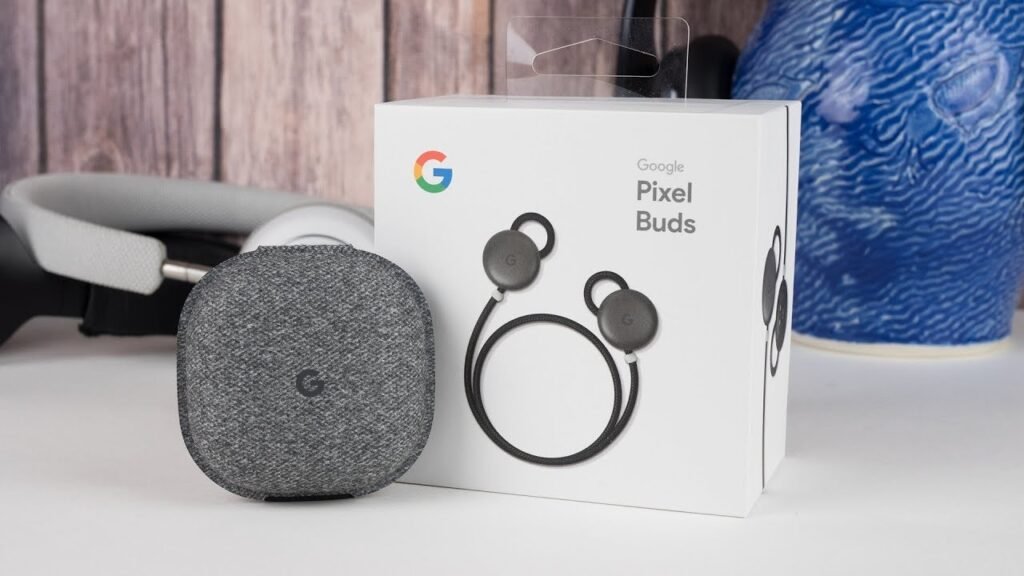In October 2017, alongside the launch of the Pixel 2 smartphone, Google unveiled its first foray into personal audio hardware: the Google Pixel Buds. This was not just another pair of Bluetooth earbuds; it was an ambitious statement. In a market where true wireless was just beginning to take hold, Google presented a device designed not just for listening, but for communicating and accessing the power of Google Assistant, headlined by a futuristic, real-time translation feature that captured the world’s imagination.
Design and Fit: A Unique (and Divisive) Approach

The original Pixel Buds immediately stood out with a design unlike anything else on the market.
- Neckband Form Factor: They were not “true wireless.” The two earbuds were connected by a durable, fabric-covered cord designed to be draped behind the neck. This design choice meant you couldn’t lose a single bud and could easily let them hang around your neck when not in use.
- Adjustable Ear Loop: The fit mechanism was unique. The earbud itself was a hard plastic disc that rested in the concha of the ear. The attached cord could be pulled to form an adjustable loop, which was meant to tuck into the upper fold of the ear to create a secure fit.
- Comfort and Security: This fit system was polarizing. For some users, it provided a surprisingly secure and stable fit, even during light activity. However, for a significant number of people, the hard plastic design became uncomfortable over time, and getting the cord loop adjusted correctly was often a fiddly, frustrating process.
- Fabric Charging Case: The pocket-sized charging case was covered in the same pleasant fabric as Google’s Home Mini speakers, creating a cohesive ecosystem feel. To charge the buds, you had to carefully wrap the cord around the inside of the case in a specific way and place the earbuds in their magnetic cradles—a process that was novel but could feel cumbersome.
- Colors: The Pixel Buds launched in colors designed to match the Pixel 2: “Just Black,” “Clearly White,” and “Kinda Blue.”
The “Babel Fish” Dream: Real-Time Translation
The defining feature and main selling point of the 2017 Pixel Buds was their integration with Google Translate for real-time conversations. The concept was straight out of science fiction:
- How It Worked: When paired with a Pixel phone, a user could tap and hold the right earbud and speak a phrase like, “Help me speak Spanish.” The phone would then enter conversation mode. The user would speak in their language, and the phone’s speaker would play the translation aloud. The other person would speak back into the phone, and the translated audio would be played privately into the user’s earbud.
- The Reality: While the feature worked and felt futuristic, it wasn’t the seamless, invisible “Babel Fish” from The Hitchhiker’s Guide to the Galaxy. It was essentially a clever, hands-free user interface for the Google Translate app. It required handing your phone to a stranger and was subject to the same delays and potential inaccuracies as the app itself. It was an amazing proof-of-concept but often clunky in real-world use.
Smart Features and Audio Experience
Beyond translation, the Pixel Buds were designed as a wearable extension of Google Assistant.
- Deep Assistant Integration: The right earbud housed a large, touch-sensitive surface. A simple tap and hold would summon Google Assistant, allowing users to make calls, send texts, get directions, control music, and ask questions without ever touching their phone. The earbuds would also read incoming notifications aloud and even allow for quick, dictated replies.
- Touch Controls: Simple gestures controlled media: a tap for play/pause and answering calls, and a forward or backward swipe to adjust volume.
- Audio Quality: The sound quality of the original Pixel Buds was generally considered adequate but unremarkable. It was clear and fine for podcasts and casual music listening, but it lacked the deep bass and rich detail found in more audio-focused competitors. The semi-occluded design also meant they let in a significant amount of ambient noise. Clearly, the focus was on the smart features, not audiophile-grade sound.
Hardware and Battery Life
- Connectivity: The Pixel Buds connected via standard Bluetooth and featured Google’s “Fast Pair” for quick, easy setup with compatible Android phones.
- Battery: On a full charge, the earbuds provided around 5 hours of listening time. The compact charging case held an additional four charges, for a total of approximately 24 hours of listening time away from a power outlet. The case itself charged via USB-C.
Reception and Legacy
The first-generation Pixel Buds received mixed reviews. The concept and the ambition were almost universally praised. The deep Google Assistant integration was a highlight, and the real-time translation feature, while imperfect, offered a genuine glimpse into the future of personal technology.
However, the product was held back by its execution. The uncomfortable fit for many users was a major issue, and the clunky reality of the translation feature didn’t quite live up to the seamless marketing. In an era where Apple’s AirPods had already established the convenience of a true wireless design, the Pixel Buds’ neckband felt a step behind.
Ultimately, the 2017 Pixel Buds are best remembered as a flawed but important first step. They were a public declaration of Google’s intent for the product line: to create earbuds that were not just about audio consumption, but about providing helpful, intelligent, and uniquely “Google” experiences. They laid the conceptual groundwork and provided valuable lessons that would directly inform the far more refined and successful true wireless models that came in the following years.
